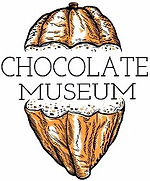

Week 11 - Van Houten cocoa powder
K for Kakawa
Kakawa, where we get the word "cacao" used in modern languages, dates back to populations living in Central and South America before the Maya, at least 1,000 years BC.
The Mayans called their cacao-based beverage Kakawa. The crushed cacao beans were mixed into water which was poured from one vessel to another, infusing the cacao and forming an aromatic froth. They had already invented the “tea pot” with a lip to help with pouring the liquid, or with a twist-on lid and a handle to enable the transport or storage of the drink.
Ancient pottery was found with inscriptions of different Kakawa recipes, made with the cocoa fruit pulp or roasted beans, and combinations of chilli, vanilla, flowers, seeds, maybe honey or agave to make a sweet beverage, and annatto, a red colorant from seeds that symbolised blood in their rituals, as it was their overall belief that cacao was a vehicle for vital power of divine origin. Mayan priests even performed baptism with Kakawa similar to use of holy water.***
So, no doubt that Mr Van Houten was on the right track.
As early as 1815, Van Houten was already looking for a way to extract the cocoa butter from the cocoa bean. The breakthrough came in 1828 when he invented an hydraulic press machine which separated the ingredients. He obtained cocoa solids (known as the “cake”) and the fat, cocoa butter. The very dry “cake”, which contained very little cocoa butter, could then be pulverised into a powder.
This led to the creation of hot chocolate in powder form. As a result, hot chocolate became accessible and easy to prepare. It enabled a democratisation of cocoa consumption, dethroning the thick and foamy hot chocolate that had been reserved to the aristocracy.
Van Houten improved his recipe by adding alkaline salts to the powder to blend better with water, this became known as the “Dutching process”. As a large-scale manufacture of cheaper chocolate, he gained in popularity all over Europe and USA.
By the end of the 1800s, Van Houten entered into fierce competition with the main English cocoa powder brands, Fry’s, Cadbury’s and Rowntree, selling his powder to 50% of the British market. The Van Houten brand name and process is still in use today.
***References: "The Secret Life of Chocolate" by Marcos Patchett
To download files
BUTTONS



A-Z MENU



LETTER L
We thank you for your participation,
Programme in partnership with Melange Chocolate
Principal Sources:
"The True history of Chocolate" Thames & Hudson
"Encyclopedie du chocolate et de la confiserie" AFCC
"Collecting the World: The Life and Curiosity of Hans Sloane" by James Delbourgo
"Chocolate Wars" by Deborah Cadbury
"The Secret Life of Chocolate" by Marcos Patchett


